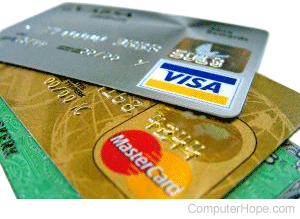Is online banking safe?

Yes. Online banking is safe with proper precautions. The following sections detail safety steps for online banking and ways your information may be compromised.
Visit bank by typing the address
Many attackers get into someone's bank account by tricking a user into thinking they're logging into their account when they're really not. This technique, known as phishing, is often done through e-mail. For example, a phishing e-mail may indicate you must verify a purchase or something else that requires you to log in to your bank account via a link in the e-mail. In reality, the e-mail link points to a fake page that logs your account information when entered.
Phishing can be avoided by never clicking a link to visit your online bank. Instead, to log in to your bank, visit it through a bookmark you created in your browser or by typing your bank's URL (uniform resource locator).
Make sure the page is secure when entering data
A web page that encrypts data has a small lock (![]() ) in the bottom corner of the window or next to the address bar. Also, the URL starts with https:// instead of http://. If none of this is seen, all data is not secure, and anything entered could be captured and read by someone.
) in the bottom corner of the window or next to the address bar. Also, the URL starts with https:// instead of http://. If none of this is seen, all data is not secure, and anything entered could be captured and read by someone.
All Computer Hope pages, including this one, are secure and show all the above.
New versions of Google Chrome may hide the start of the URL. You should still see a lock, but to see the front portion of a URL in the address bar, you must click in the address bar twice.
When you visit your online bank login page, verify you see this lock before entering your username and password. If you do not see this, do not log in to the page.
Click the lock icon in most browsers to view the website's security information, including their certificate details.
Never send usernames, passwords, etc. through e-mail
No bank ever requests you to send personal information over e-mail. Never send your username, password, PIN (personal identification number), account information, credit card, etc. over e-mail. E-mail is unencrypted and, if intercepted by a third-party, could be read. It's also often stored on a server; if that server is compromised, the attacker could read that e-mail with your information.
Be cautious where you log into your bank
Business
For most users, we suggest only logging into your online bank page while at home. Your place of work can install key loggers or use other methods of monitoring you while online. Someone who has access to this information could access the keystroke logs, which would contain everything you've typed, including your usernames and passwords.
Wireless network
On a wireless network, all information sent to and from your computer to the wireless router may be intercepted by someone nearby. Therefore, when you log in to your online bank page while on a wireless network, make sure the network you're connecting to is secure using WPA (Wi-Fi Protected Access).
Friend's house
Be concerned when logging in to an account from a friend's computer. A computer you're not familiar with could intentionally or unintentionally log usernames and passwords that could be used to access your account.
Use a strong password
The password you're using to log in to your online bank should be a strong password. What this means is that it shouldn't be something easily guessed, such as your pet's name. Your banking password should have a number, special character, and different capitalization. See the password definition for additional information, links, and examples.
Enable two factor authentication
Most banks today have some form of two factor authentication. Enabling this service on your bank and your e-mail account helps protect your account even if someone were to have your username and password.
Don't save your bank password
Browsers can save your username and passwords and enter them automatically to make it easier to log in to an account. We recommend not using this feature for your online bank account. It may be more difficult to enter this information each time you visit your bank, but it helps keep your account safer.
Make sure your computer is protected
Finally, it's always a good idea to protect your computer. When an attacker attacks or infects a computer, they could install a keylogger that logs each keystroke you enter on a computer. These can capture your username, password, and confidential data.
